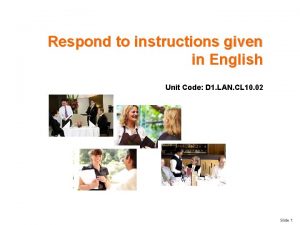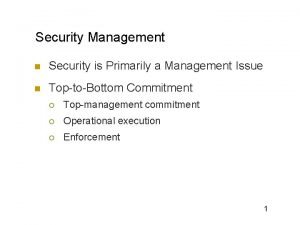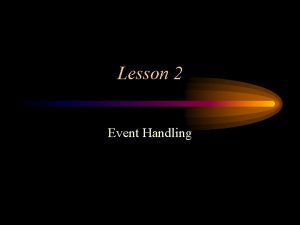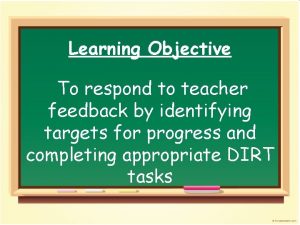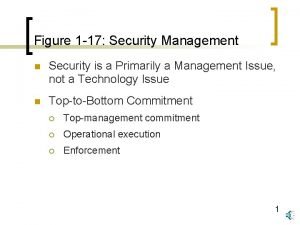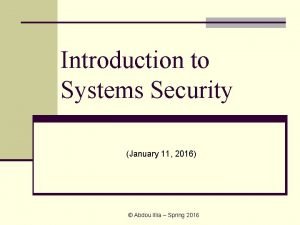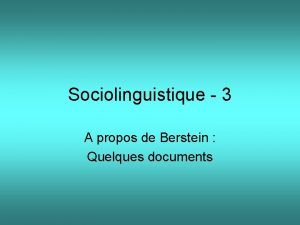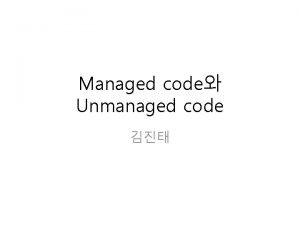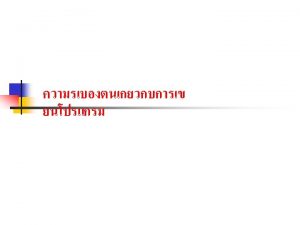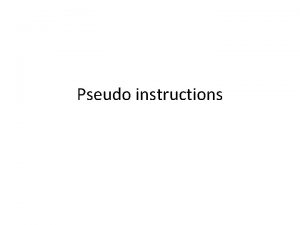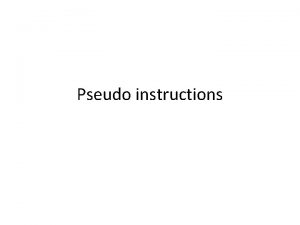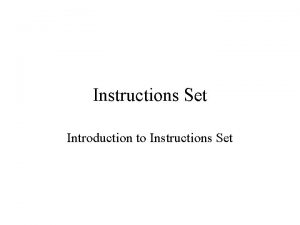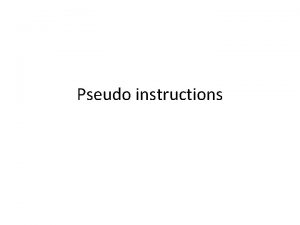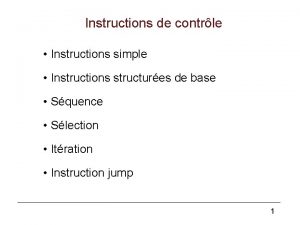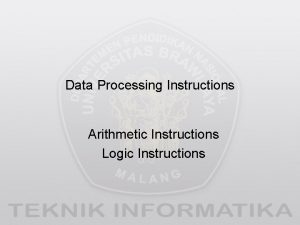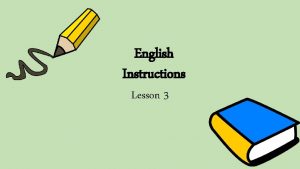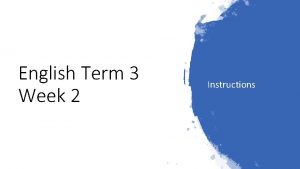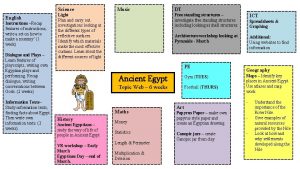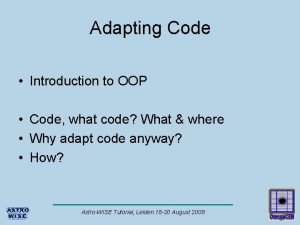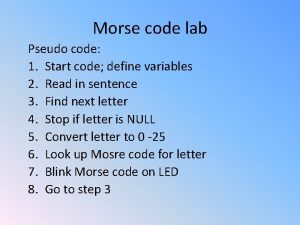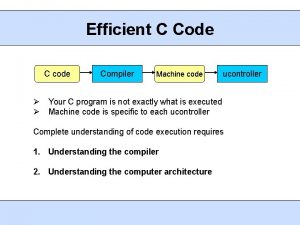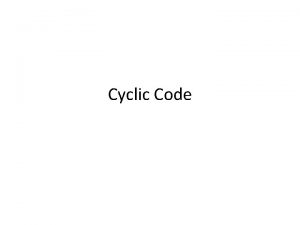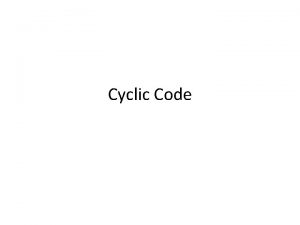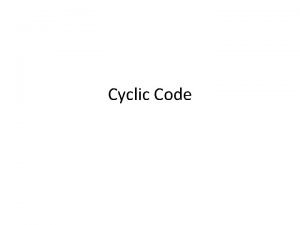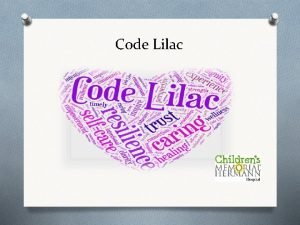Respond to instructions given in English Unit Code







































- Slides: 39

Respond to instructions given in English Unit Code: D 1. LAN. CL 10. 02 Slide 1

Respond to instructions given in English This unit is comprised of four elements: � Element 1: Respond positively to a set of verbal instructions � Element 2: Respond to simple written instructions � Element 3: Express doubt at being able to carry out instructions � Element 4: Follow routine procedures. Slide 2

Assessment for this unit may include: � Oral questions � Written questions � Work projects � Practical exercises � Role plays � Formal report from employer/supervisor. Slide 3

Element 1: Respond positively to a set of verbal instructions Performance Criteria for this Element are: � 1. 1 Acknowledge and respond positively to a set of instructions given in the workplace � 1. 2 Use appropriate body language to indicate understanding � 1. 3 Ask questions to confirm understanding. Slide 4

Acknowledge and respond positively to a set of instructions given in the workplace � A phrasal verb is a verb + a preposition or adverb. For example: take off, put on, pick up, turn on, lift quickly � A preposition can include a description of: place or time. For example: on, at, in front of, behind, before, after. Slide 5

Acknowledge and respond positively to a set of instructions given in the workplace Activity: � Listen to the instructions from your trainer � Write down what you hear in the correct order � In pairs, try to complete the task. Slide 6

Use appropriate body language to indicate understanding Body language: � Body language is an important part of non-verbal communication � There are many ways that you use body language to send information to other people during a conversation � Different cultures use body language in different ways. Slide 7

Use appropriate body language to indicate understanding When listening to instructions it is important to let the instructor know that you understand by using body language, such as: � Nod your head � Say ok, I understand � Repeat what the instructor tells you � Pick up or point to the items, materials, or utensils that the instructor describes � Use thumbs up or ok hand gestures. Slide 8

Ask questions to confirm understanding There are many different ways to ask questions about instructions in English: � Open-ended questions – more general, variety of responses � Closed questions – require less information and may often just need a ‘yes’ or ‘no’ answer. Slide 9

Ask questions to confirm understanding Useful language: � So, I should ………… then …………, is that correct? � Should I …………? � Could you explain that step again, please? � What do I do after that? � How long………. . ? � Ok, first I ……. and after that I ……. . , is that right? Slide 10

Ask questions to confirm understanding Sail napkin activity: Slide 11

Respond to simple written instructions Performance criteria for this element: � 2. 1 Confirm understanding of supervisor’s instructions � 2. 2 Request repetition or clarification of instructions or requests � 2. 3 Complete flowcharts or diagrams to confirm understanding of instructions. Slide 12

Confirm understanding of supervisor’s instructions Useful language: � Yes, I can do that � Yes, I understand � Not a problem. I will do it now � OK, I’ll do that straight away � Sure thing, I’ll start on that now � I’ve got it. I’ll have that ready for you by tomorrow morning � Responding to a question with a closed statement with ‘Yes’ or ‘No’. Slide 13

Request repetition or clarification of instructions or requests Introduction: � Listening to and reading instructions in a second language is challenging and it is essential that you understand the details correctly � It is important to be able to listen for key words and information � It is necessary to feel confident enough to ask your supervisor to repeat instructions or to check your understanding, in order to make sure you understand exactly what you are required to do. Slide 14

Request repetition or clarification of instructions or requests Useful language: � Ask the instructor to repeat the details � Ask the instructor to speak louder if you can’t hear or to slow down � Ask the instructor to clarify details using closed questions � Ask open-ended questions for extra details � Remember, it is important to remain polite when asking for extra support! Slide 15

Request repetition or clarification of instructions or requests Slide 16

Complete flowcharts or diagrams to confirm understanding of instructions Step 1 Step 2 Step 3 Slide 17

Complete flowcharts or diagrams to confirm understanding of instructions Step 1 Step 2 Step 3 Slide 18

Complete flowcharts or diagrams to confirm understanding of instructions Step 1 Step 5 Step 4 Step 2 Step 3 Slide 19

Complete flowcharts or diagrams to confirm understanding of instructions General Manager Assistant Manager Chief Accountant Front Office Manager F&B Manager Slide 20

Complete flowcharts or diagrams to confirm understanding of instructions Director- Personal Assistant - Chief Accountant - Human Resources Manager- Sales & Marketing Manager - Facilities Manager - Slide 21

Complete flowcharts or diagrams to confirm understanding of instructions Step 1: Step 2: Step 3: Step 4: Step 5: Slide 22

Element 3: Express doubt about being able to carry out instructions Performance criteria for this element are: � 3. 1 Identify problems associated with completing a set of instructions � 3. 2 Seek and offer solutions to potential problems � 3. 3 Confirm understanding of contingency instructions. Slide 23

Identify problems associated with completing a set of instructions Slide 24

Seek and offer solutions to common problems Supervisor and travel agent dialogue Supervisor: “I need you to book the ACME group on the 11 am flight tomorrow. There are 20 people and they will all have luggage. ” Travel agent: “I will make the booking straight away. ” (Travel agent checks availability) “I tried to make the booking for 11 am but it seems there are not enough seats available. I checked the later flight at 2 pm tomorrow and there are enough seats for the group. Should I book the 2 pm flight instead? ” Supervisor: “Ok. That should be fine!” Slide 25

Confirm understanding of contingency instructions As you have seen in this element, sometimes instructions are unable to be completed due to unforeseen issues or problems like the weather or a lack of understanding: � In these cases, your supervisor may provide you with some contingency instructions which explain what to do if something doesn’t work the way it is supposed to � This means you must listen or understand more than one set of instructions to complete one set of tasks. Slide 26

Confirm understanding of contingency instructions Example (100% certain): ‘When it rains, bring in the chairs and tables. ’ Example (80% certain): ‘When it rains, you should bring in the chairs and tables. ’ Example (50% certain): ‘When it rains, you could bring in the chairs and tables. ’ Example (100% certain): ‘When it rains, you must bring in the chairs and tables. ’ Slide 27

Element 4: Follow routine procedures The performance criteria for this element are: � 4. 1 Demonstrate understanding of a set of instructions by carrying out a routine job � 4. 2 Explain exceptions to routine procedure � 4. 3 Discuss ways to improve routine procedures. Slide 28

Demonstrate understanding of a set of instructions by carrying out a routine job You can let your supervisor know you understand what to do by: � Saying you understand � Repeating the instructions or contingency instructions � Demonstrating you can complete the instructions successfully. Slide 29

Demonstrate understanding of a set of instructions by carrying out a routine job Slide 30

Demonstrate understanding of a set of instructions by carrying out a routine job Slide 31

Explain exceptions to routine instructions There are many routine procedures that you will be required to complete each day in your job. For example: � Answering the telephone � Cleaning the floor � Taking a booking � Responding to enquiries � Booking a tour. Slide 32

Explain exceptions to routine instructions Step 1: First, place your dinner plate on the table in front of where people are sitting. Make sure it is a few centimetres in from the edge of the table. Step 2: Next, place your cutlery starting from the left side of the plate. Step 3: After that, place the cutlery on the right-hand side of the plate beginning with a soup spoon, then a teaspoon for the sorbet and then the dinner knife. Step 4: Finally, place a water glass at the top of dinner knife and a wine glass above the soup spoon but slightly closer to the edge of the table. Step 5: Finish the table setting by putting a clean cloth napkin on the dinner plate. Slide 33

Explain exceptions to routine instructions Adverbs of frequency describe how often something happens. For example: � Usually � Always � Never � Sometimes � Occasionally. Slide 34

Discuss ways to improve routine procedures In many organisations, standard operating procedures or routine procedures have been implemented for long periods of time. Improving procedures can: � Provide positive benefits to an organisation � Provide cost savings � Develop safer conditions � Increase efficiency. Slide 35

Discuss ways to improve routine procedures Step 1 • Fill a sink with warm water and detergent • Put a clean cloth in the sink and soak it Step 2 • Take the cloth to the table • Wipe the table Step 3 • Take the cloth back to the sink and rinse it • Go back to the table and clean again Slide 36

Discuss ways to improve routine procedures Step 1: Let the phone ring at least 5 times before answering Step 2: Answer the phone and wait for the person to say something. Step 3: Tell the person to wait while you finish your lunch Step 4: Say hello! Step 5: Tell the person you will get a manager. Slide 37

Discuss ways to improve routine procedures � Write down a set of instructions for a routine procedure at your workplace � In small groups share your instructions and discuss ways that you could improve the procedure � Share the suggestions with the whole class: Slide 38

Finish: Thank you! Slide 39
 Responding to instructions
Responding to instructions Code commit code build code deploy
Code commit code build code deploy English unit conversions
English unit conversions Unit 10, unit 10 review tests, unit 10 general test
Unit 10, unit 10 review tests, unit 10 general test Vector directed line segment
Vector directed line segment Stimulus in animals
Stimulus in animals Plan protect respond cycle
Plan protect respond cycle Example of inquiry letter for business
Example of inquiry letter for business Object respond to an event by writing
Object respond to an event by writing How do consumers respond to various marketing efforts
How do consumers respond to various marketing efforts Thermostatic expansion valves respond to changes in
Thermostatic expansion valves respond to changes in How to respond to teacher feedback
How to respond to teacher feedback Ni hao ma
Ni hao ma How to respond to a quotation request
How to respond to a quotation request Plan protect respond cycle
Plan protect respond cycle Producers respond to consumers' positive economic votes by
Producers respond to consumers' positive economic votes by Brain warmer
Brain warmer Respond picture
Respond picture What news does antonio receive at the play’s end ?
What news does antonio receive at the play’s end ? The plan-protect-respond cycle
The plan-protect-respond cycle Show me your ways o lord teach me your paths
Show me your ways o lord teach me your paths Respond to decision letter
Respond to decision letter Respond to
Respond to Respond to
Respond to The plan-protect-respond cycle
The plan-protect-respond cycle Respond to
Respond to Chemical signalling
Chemical signalling Respond census gov nscg
Respond census gov nscg Prepare mitigate respond recover
Prepare mitigate respond recover What are three stimuli that plants respond to
What are three stimuli that plants respond to Setting of metamorphosis
Setting of metamorphosis Lara listen affirm respond add
Lara listen affirm respond add How does thoreau respond to being jailed
How does thoreau respond to being jailed Chapter 19 confusion dementia and alzheimer's disease
Chapter 19 confusion dementia and alzheimer's disease Code élaboré code restreint
Code élaboré code restreint Managed and unmanaged code
Managed and unmanaged code Apa itu assembler
Apa itu assembler Difference between source code and machine code
Difference between source code and machine code Language choice in multilingual communities
Language choice in multilingual communities Order of bases in dna
Order of bases in dna
